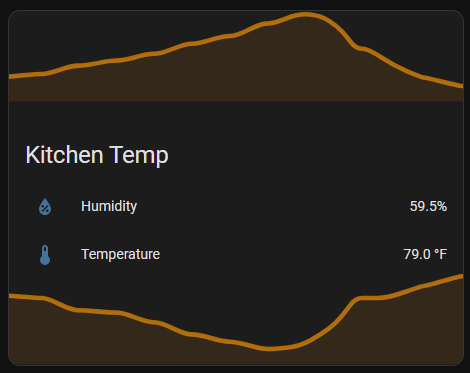Sorry if this is a newb question; I’m coming in cold. I’ve had HAOS running on an RPi4 for months, but I haven’t invested in any smart devices to connect yet.
I’d like to start with some (ideally open source) smart gauges just to check the temp out front and back. Any recommendations?
Thanks!
Grab yourself a Zigbee coordinator and some Zigbee Temperature Devices off AliExpress or from Ikea if you’re willing to pay more.
thanks!
I’m a bit late, but if it helps, I’ve had good results with the Sonoff and Tuya zigbee sensors. I prefer the Tuyas, just because they use AA instead of CR2032 batteries.
$50 will easily get you everything you need to start.You might also want to think about getting a 433MHz radio for the system.
If you live in a built up area, you’d be surprised how many people have equipment transmitting on 433MHz already (free data!).
And a lot of generic wireless temperature sensor kits use it as a standard, making it a good value way to get weatherproof gear.
I got a generic fridge/freezer kit for about £10 that works perfectly with this. Again, $50 or so for a DVB-T2 receiver. Just be aware that it’s a little more technically involved than pairing zigbee devices.Bother me with DMs if you like, I’ve been fiddling with just about every protocol I can get my hands on for under £100!
interesting, thanks!
Like others have said, ZigBee is the way to go for low-traffic things like temperature sensors. It uses a lot less power than WiFi, so battery-powered devices can last for months on a CR2032.
I’ve got some Aqara temperature/humidity sensors that I have hooked up to my Smartthings Hub and then imported into Home Assistant through the cloud, but you can use any ZigBee adapter that works with Home Assistant: https://community.home-assistant.io/t/using-aqara-temp-and-humidity-sensor/408166/9.
I also recently got some Sensibo Elements boxes, which are wall-powered WiFi air quality sensors that include temperature/humidity. They have an official HA integration. If you go for them, don’t worry about the sale countdown on the website; it doesn’t actually seem to ever end.
thanks!
If you’re trying to avoid a whole zigbee or zwave network, Govee makes some inexpensive battery-powered bluetooth thermometer/hygrometers, and have a HA integration, but bluetooth can be tricky to get running on Pis. I feel like most of the actual wifi devices are phone-home type setups. My govee thermometers have pretty good range - one of them even reads from inside the refrigerator.
thanks!
Have you considered other protocols, especially ZigBee?
Zigbee is mentioned all the time. Guess I’ll have to look into them…
I’ve tried a few other ZigBee Coordinators and this is the only one I can really suggest. Home Assistant even has their own that used to be called Sky Connect. I was having things randomly drop off my network with Sky Connect.
Get the one that has experimental Matter-over-thread support for future-proofing. You can even get it with POE support if that’s helpful for you.
I would recommend this product from Shelly https://www.shelly.com/en-us/products/shop/shelly-h-and-t-gen3-1
Doesn’t no app or hub requried, works via wifi or bluetooth, has an e-ink display to conserve battery. I’ve had it since October and its been running without issue. Uses 4 AA batteries which I haven’t changed at all and are still above 75%!
There’s a newer generation (I have the previous one) so I can only imagine its even better.
This looks great! Is it definitely HA compatible?
Yep! The device has a built-in web server. You connect via it’s IP from any browser and configure it how you want. Here’s what it looks like in homeassistant.
Overview:

Historical data:

Damn, that’s cool! 😉 Thanks, this is perfect!
Outdoor, Indoor? Wifi, Zigbee? mains power, battery?
Outdoor. I assune wifi-enabled, but I’m a newb and looking for advice. Zigbee keeps getting mentioned, so I guess I’ll be looking into that. thanks!
The thing with wifi is that it drains a shit ton of energy. A WiFi temperature sensor might last a few weeks or months but ZigBee devices can last years. Of course this depends on what kind of batteries were talking about.
WiFi also usually means an internet portal, which impacts responsiveness, potentially violates privacy, and leaves you at the mercy of a company continuing to provide the service.
Zigbee is not just cheaper and uses less power, but it’s open and local so there’s not some company accumulating your data to sell and you’re not at their mercy
Yup, all valid points which contributed to me either using ZigBee or designing my own things for WiFi.
Can anyone recommend any matter based sensors? I too haven’t purchased any devices yet and figured I might as well try to build out with matter to have a single strong network instead of many weaker ones, and aiui matter will likely win out over ZigBee in the long term?
- what other measurements might you care about, for combination sensors?
- how frequent?
I have Shelby flood sensors in the basement, based on WiFi. They were cheap and the batteries last over a year. While they do have an online portal, the HA integration can read them locally. One of the things I get from it is a graph of temperatures, however the data points can be an hour or more apart.
Not sure if you’re still researching, but I really like the Bluetooth ones.
For the Pi4, I use a little USB Bluetooth adapter from pluggable ($13-ish) on a 10-ft USB extension cable to get the module away from other things. I think the pi has Bluetooth built in? But I never got it working. But generic little Bluetooth USB things are perfect. With the USB extension cable I have great whole-house coverage (small house though)
Then for the sensors, I get a 3pk SwitchBot IP65 indoor/outdoor hygrometer.
They’re on sale on Amazon right now for $25-ish for 3, so it’s a pretty good deal.
As far as placement, I have some outside - they’re fine. I try to place them where they’re not getting totally hosed by rain or snow - under a tree or in the greenhouse or under my garage eaves sheltered from direct sunlight and rain.
They are very low power consumption (2x AAA batteries included) and I’ve had some running over a year and they still have more than 50% battery. (The battery level does report to home assistant)
They show up on home assistant immediately after powering up - no apps or anything needed. Just adopt them and set their location in the home assistant settings.






